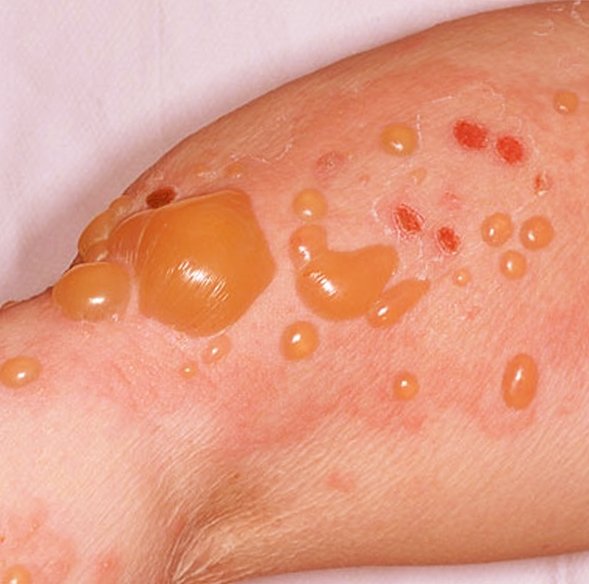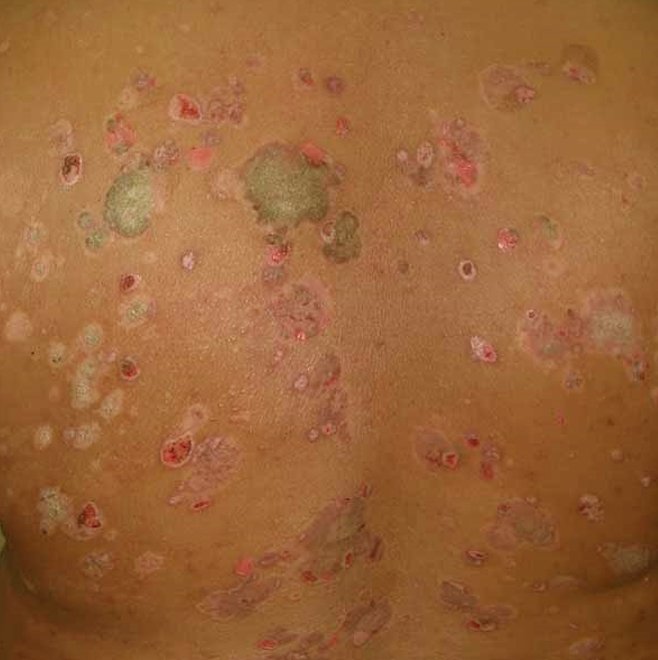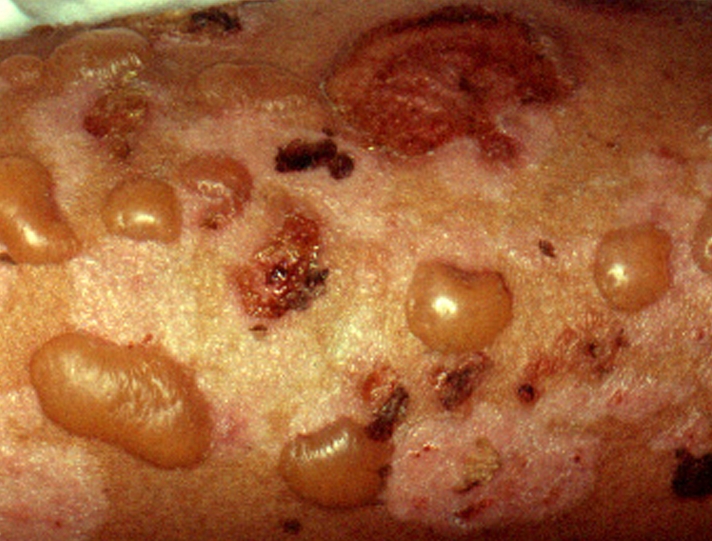Bullous Pemphigoid
What is Bullous Pemphigoid?
Bullous pemphigoid is a chronic and autoimmune disorder that is characterized by blisters on the skin. The other body part that is affected of this skin problem is the mucous membranes or our mouths.
This skin disorder, bullous pemphigoid, is a rare condition that its frequency of occurrence is unknown to the public in the United States. But this skin problem is said to be reported in France and Germany, making Europe to have bullous pemphigoid the most common autoimmune blistering disease. The incidence of bullous pemphigoid was found to be in the number of 4 cases per 100,000 persons a year in the UK. There has been no racial preference for bullous pemphigoid. Bullous pemphigoid also affects men and women equally. The condition is also reported to affect those who are elderly; an average onset of 65 years is noted. This is a rare condition to the young and children. Others are alarmed if this condition can be transmitted from one person to another. The answer is no, for the condition is an autoimmune disorder, where one only acquires because of an abnormal immune action.
Bullous Pemphigoid Symptoms
The initial signs and symptoms of this skin disease is said to be small patches of an itchy skin. It is observed that the blisters shall burst after several days but then heals. The itchiness would usually be sensed as burning sensation. The blisters are firm in shape and are dome-like in structure. When the mouth is affected, the person shall experience burning sensations in the mucous membranes and shall be sensitive to acidic foods. When the blisters break in the mouth, they form to erosions similar to mouth ulcers. Unfortunately, this skin problem can stay long in a person’s system, even taking up at least a year or so. This skin disorder has several other characteristics and shall be discussed below:
Generalized bullous pemphigoid
This is the most common characteristic of the skin disease. There are bullae or blisters that are filled with fluid which sprout at any skin surface. The oral mucosa is rarely affected and is considered minor. Scars are not usual and should not be a worry to the affected.
Vesicular bullous pemphigoid
This is a less common type of BP. This usually manifests groups of small, tense blisters.
Vegetative bullous pemphigoid
It is a rare form that involves vegetating plaques in the areas of the skin such as the armpits, neck, groin and mammary areas.
Generalized erythroderma bullous pemphigoid
This skin disorder would usually resemble psoriasis. There is generalized atopic dermatitis with various developing vesicles or bullae.
Urticarial bullous pemphigoid
This type of BP would usually start with persistent urticarial (skin rash that are pale red) lesions that would then develop into bullous eruptions. Others would only have urticarial lesions apart from bullous eruptions.
Nodular bullous pemphigoid
This is a rare presentation of BP that clinical feature and resembles itself with blisters arising from a nodular lesion skin.
Arcal bullous pemphigoid
Usually, a childhood-onset is found for this condition due to vaccination. The bullous lesions would usually sprout on the palms, soles of the feet and the face.
Infant bullous pemphigoid
The infants are not spared of this skin disease. Usually the blisters occur on the palms, soles, face while the genitals are areas rarely affected too.
Bullous Pemphigoid Causes
The development of an autoimmune disorder is again a wonder to all of us. This skin condition is idiopathic, meaning from an unknown cause. The mechanism of an autoimmune disorder is to attack one’s own body defenses making a person susceptible to disorders such as bullous pemphigoid. There are also triggering factors for this skin condition and it includes ulcerative colitis and multiple sclerosis. Medication such as furosemide, NSAIDs, captopril, penicillamine, radiation therapy and ultraviolet radiation are supposedly said to cause this condition.
Bullous Pemphigoid Diagnosis
As this condition is left untreated and uncared for, it shall persist for months and even years with periods of remissions then exacerbations. It is very important that one should seek medical help as soon the condition is found out and diagnosed. The diagnosis of the skin ailment is done through a skin biopsy. The serum antibody titers would also identify for the presence for certain antigens for bullous pemphigoid. This can be differentially diagnosed because this condition is usually associated with other skin disorders such as SLE and skin cancer. The antibody can also be detected in one’s urine or in blister fluid.
Bullous Pemphigoid Treatment
The aim of the treatment for bullous pemphigoid is to suppress one’s own immune system. Since the condition involves the immune process, return of the normal funcitioning of the immune system is a must. Here are the following treatments for bullous pemphigoid:
Steroids
These would include prednisolone, known as a traditional treatment for BP. The mechanism of steroids is to reduce the inflammation and suppress the immune system. Initial treatment for this condition should be in high dose for to readily act on the blisters and clear them up. Low dose can be provided as the symptoms have subsided as it is used as maintenance and a control of the symptoms. This type of drug can be in creams or known as a topical steroid cream. This is only recommended to apply on small area of blisters and not on extensive blisters. Any type of BP is suitable for this condition. The conjunction of oral and cream steroids is very much appreciated.
Antibiotic creams or tablet
This can be very helpful in avoiding and treating infections. It is a possibility for this can reduce or avoid another problem. Tetracycline is recommended as well as nicotanamide. Dapsone and erythromycin are recommended also for this condition.
Clean the blisters frequently
Wound care should be done in order to avoid worsening of the condition. This can also avoid infections.
Other immunosuppressant
These would help in suppressing the immune system but has untoward effect for it can make the person susceptible to infections. But the good part is that the person shall attain reduction of the blisters and inflammation. These are the recommended drugs: azathioprine, methotrexate, and mycophenolate mofetil.
Prognosis
The prognosis of this skin condition is good especially when the person affected is very much compliant with the treatment provided for. It is believed that bullous pemphigoid would fully go away after 1 to 5 years, along with the treatment. As this is attained, treatment for bullous pemphigoid is stopped. But there are rare instances where the skin problem can lead to death. This is because a person affected has not been compliant with the treatment course and has contracted an infection. When the infection was not controlled it is truly a possibility that the person can die of sepsis. Better consult a doctor when a skin condition has sprouted to avoid the downside of the disease.
Bullous Pemphigoid Pictures
Photos, Images and Pictures of Bullous Pemphigoid…








